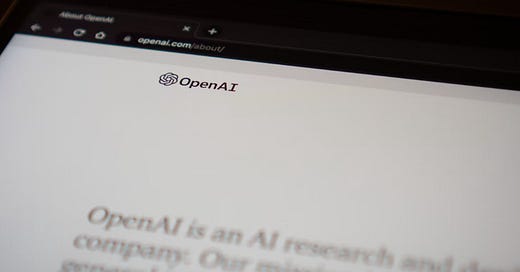OpenAI's growth is one of the most astounding business results of all time
Welcome back to Cautious Optimism! Today is June 13th, 2024. There are three new This Week in Startups episodes live out this week with your humble scribe as co-host. Available wherever you get podcasts or here on YouTube. — Alex
Trending Up: Extreme methods to halt sea-level rise … expectation of two rate cuts this year … the chance that Musk’s massive pay package goes through … Tesla’s stock … Apple’s dealmaking prowess … OpenAI’s revenue (more below) … Broadcom shares …

Trending Down: Wholesale prices … European stocks … Spotify’s music streaming royalties … EV sales in some countries … Brex’s cash burn … Byju’s ability to wipe out prior investors … Florida’s drivability … insurance affordability … Greece’s ability to handle current heat levels … crypto-skepticism at the Federal level …
Race to the Top: This morning, Apple is worth $3.27 trillion. Microsoft $3.28 trillion. That’s so close as to be all but the same number. At the same time, Nvidia is worth $3.08 trillion, while Amazon and Meta are worth $1.94 trillion and $1.29 trillion, respectively. Even amongst the most valuable tech companies, we’re starting to see a power law play out in terms of the companies worth a lot and the companies worth a lot a lot.
Race to the Bottom: After (allegedly, etc) plagiarizing and getting called out for it by Forbes and others, AI search startup Perplexity wants you to know that it will forge business relationships with publishers. A bit late, yeah? The startup now gets to try to do what is right while combatting a self-inflicted rift with the companies it needs to work with. Whoops. Perplexity broke our rule that tech companies should go fast without being a jackass.
OpenAI’s revenue growth is flat-out bonkers
The Information reported, and Bloomberg confirmed that OpenAI’s revenue has scaled massively thus far in 2024, rising from a $1.6 billion annualized run rate towards the end of 2023 to around $3.4 billion today. Of that total, around $200 million comes from its partnership with Microsoft’s Azure cloud service, which offers OpenAI models. The rest the company generates on its own.
A run rate of $3.4 billion works out to monthly revenue of just over $283 million. The $1.8 billion in new annual run rate that OpenAI added since late last year is worth $150 million of that monthly total.
OpenAI’s revenue growth is one of the most astounding business results ever.
It’s not rare to see private-market tech companies post triple-digit top-line growth when they are small. It’s easier, after all, to double a $10 million run rate than it is a $50 million run rate. And it’s easier to double a $50 million run rate than a $250 million run rate.
To more than double from an annualized revenue base of $1.6 billion in less than a year is hard to fully grok, but the company’s performance does help us understand a few things that we’ve seen in the market:
OpenAI’s revenue growth explains why so many VCs and other wealthy entities are busy stuffing capital into its rivals. Mistral’s recent round might feel strange, given that it is forced to compete with the largest tech companies and their vassals. But if OpenAI can grow as much as it has recently demonstrated it can, the market it hopes to dominate is so large that it should be able to support multiple healthy competitors.
People are willing to pay for AI tools. We do not know today is what share of OpenAI’s revenue comes from folks like myself who pay $20 each month for access to its newest models and what portion comes from larger corporate customers. But no matter how you estimate its revenue mix, there’s clearly ample demand for what OpenAI has cooking from a wide customer base. That’s good for both consumer-facing AI companies and their B2B kin alike.
A good question to ask is what OpenAI’s gross margins are. Its value is radically different if its revenue margins work out to 5%, 50%, or 95%. Given its partnership with Azure, I would not be shocked if the math there is not simple. But how much gross profit OpenAI can yank from each dollar of revenue it brings in will determine what sort of multiple companies of its ilk can and will eventually command on the public markets.


